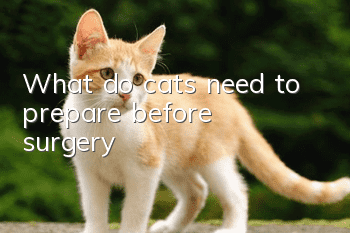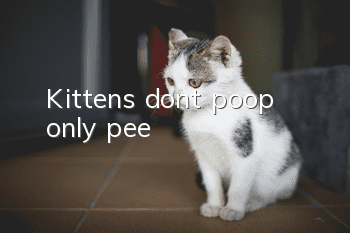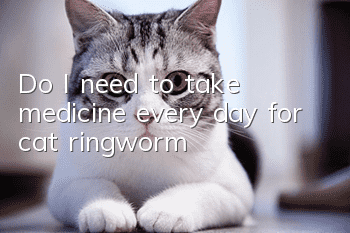What do cats need to prepare before surgery?

Cats will always go through some large and small surgeries in their life, and surgery has two extremely important parts, before and after surgery. The care before surgery can be said to determine whether the surgery will be successful. Just like us humans need all kinds of preparation before surgery, there are many things that parents and doctors should pay attention to when it comes to pre-surgery preparation for cats.
According to the different causes of surgery, we can divide surgeries into two categories, one is physiological surgery, and the other is pathological surgery.
1. Preoperative preparation
(1) Preoperative preparation for physiological surgery:
Physiological surgeries are mainly sterilization of cats, and of course also include special requirements of some parents, such as vasectomy, vocal cord removal, ear pricking, tail docking, etc. The animals undergoing these surgeries are generally in very good health unless there are some congenital malformations or lesions. In short, cats only undergo physiological surgery once in their lifetime, and no one wants to have any accidents. Therefore, it is very important to do a good job before and after surgery.
1. The owner’s preoperative preparation at home
Mainly, fasting is required for 8 hours before surgery, and water is strictly prohibited for 2-4 hours before surgery. This purpose is to prevent vomiting during anesthesia and the risk of food accidentally entering the trachea. Another important reason is that anesthetic drugs have an inhibitory effect on gastrointestinal motility, which also prevents problems caused by indigestion after surgery. Of course, in order to achieve better surgical asepsis, it is recommended to bathe the pet 3 days before the surgery to keep the body as clean as possible.
2. Preoperative preparation in the hospital
After bringing the animal to the hospital, do not blindly perform anesthesia and surgery immediately. This is very dangerous. Some animals look very healthy, but are actually in poor physical condition, and it is very dangerous to perform anesthesia and surgery on animals that are not in good physical condition. For example, the animal itself has poor renal function, but the clinical symptoms are not obvious. However, after anesthesia, physiological indicators such as blood pressure and heart rate drop, and the blood supply to the kidneys decreases, which will obviously stimulate the kidneys and lead to further decline in kidney function. Coupled with the failure to realize the insufficiency of kidney function and the use of drugs that increase the burden on the kidneys, the consequences of these problems are dire. Not only the kidneys, but also large organs such as the heart, lungs, and liver are also at risk. Therefore, whether it is physiological surgery or pathological surgery, liver, kidney, heart, lung and other functions as well as blood sugar indicators must be checked before anesthesia and surgery.
Therefore, it is recommended that the examination items that should be done before surgery include:
(1) Routine examination: including visual inspection, auscultation, and palpation. Through these routine examinations and combined with clinical experience, a large number of diseases can be diagnosed and detected. However, these inspection methods are often limited. In order to further diagnose clearly, the following inspection items need to be done.
(2) BloodRoutine: Must do. It can know whether the animal is anemic, whether there is an inflammatory reaction, the number of platelets, whether there are blood diseases, whether there are blood parasites, etc. Some diseases are not suitable for surgery, such as thrombocytopenia and various types of anemia.
(3) Biochemical examination: The examination items include six items including ALT, ALKP, TP, BUN, CRE, and GLU. These six basic items include liver and kidney, blood sugar and total protein. Why do we need to measure total protein? We must know that if the total protein is too low, the wound cannot heal. The purpose of measuring blood sugar is mainly to determine whether there is diabetes. As we all know, it is difficult for animals with diabetes to heal wounds. Therefore, it is also a must-check item.
(4) X-rays and B-ultrasound: X-rays are mainly used to examine the heart, lungs, abdominal organs, bones, etc. This examination item is not necessary and needs to be made based on the needs of clinical examination. For example, if abnormalities are found during auscultation of the heart and lungs, X-rays should be taken immediately to observe whether the heart is enlarged and whether there are abnormal shadows in the lungs; when abnormalities or pain are felt in the abdominal organs, abdominal X-rays or B-ultrasound will also Selective auxiliary diagnosis. The examination of bones is mainly done for animals suffering from vertebral body diseases or joint diseases. This can remind the surgeons to try to avoid harming these animals that have suffered from osteoarthritis during the process of keeping the animals.
3. After fully understanding the pet’s physical condition, the doctor will formulate appropriate anesthesia and surgical plans based on the situation.
(2) Preparation for pathological surgery
Under normal circumstances, most of the animals suffering from pathological surgeries will be in poor health. This makes it even more important to conduct various examinations before surgery in order to be well aware of the situation. Make corresponding adjustments to poor physical conditions before surgery, especially for animals with severe dehydration, severe imbalance of ion balance, acid-base balance, and anemia. Before anesthesia, the physical condition must be adjusted to the best state before anesthesia and surgery can be performed. . For example, in cases of cat lower urinary system obstruction, urinary catheterization fails and urethrostomy is required. However, due to the long blockage time, uremia has developed. In this case, it is definitely unrealistic to perform surgery. Surgery can only be done after It is prudent to adjust the cat's physical condition before proceeding. The adjustment time generally takes about 2 to 3 days. Otherwise, blindly performing anesthesia and surgery will not only fail to save lives, but will worsen the condition and even make the patient unable to tolerate anesthesia and surgery. For pathological non-emergency surgeries, it is also required to fast 12 hours before surgery and abstain from water 4 hours before surgery.
The biggest difference between pathological surgery and non-pathological surgery lies in choosing a more appropriate time for surgery. Minimize surgical risks.
What needs to be mentioned here is that non-open fractures, especially fractures of limb bones, are not emergencies, and surgery can be performed until the animal's physical condition is stable. The affected limb can be simply bandaged before surgery to prevent further damage to the fracture. Spinal fractures and pelvic fractures are emergencies that need to be treated according to the condition.
2. Nutritional management
Malnourished animals are often accompanied by hypoalbuminemia, which often coexists with anemia and reduced blood volume, thus reducing their ability to tolerate blood loss and shock. Low protein status affects tissue healing and may lead to secondary infection. It should be corrected as much as possible before surgery. It can be corrected in a short time by preoperative enteral administration of high-protein food or preoperative intravenous infusion of albumin.
Cats that are unable to eat on their own before surgery can consider placing a nasogastric tube to provide nutrients.
Animals that cannot be placed with a nasogastric tube (such as gastrointestinal obstruction/ulcer) are given nutrients through total parenteral nutrition (TPN). Nutrients include glucose, amino acids, lipid emulsion, and electrolytes through intravenous infusion. Vitamins etc.
Animals undergoing scheduled and elective surgery should have one week of nutritional management before surgery.
3. Treatment of specific diseases
When an animal has a specific disease that requires surgery, the specific disease should be tested and treated.
1. Diabetes
Animals with diabetes have poor anesthesia tolerance and postoperative recovery. Blood sugar and urine sugar must be tested before surgery, and insulin and infusion should be injected and treated according to the situation to control blood sugar levels within a moderately elevated range to avoid intraoperative complications. , Hypoglycemia occurs after surgery.
2. Heart disease
Animals with heart disease must have their blood oxygen and blood pressure tested before surgery, and be given oxygen therapy and blood pressure-lowering drugs. At the same time, low-salt and diuretic drugs used in the long-term treatment of animals with heart disease can easily cause water and electrolyte disorders, so they should be treated during surgery. Provide correction beforehand.
3. Liver disease
Animals suffering from liver disease should undergo a complete liver function test before surgery, and undergo hepatoprotective treatment and nutritional therapy. Time-limited or elective surgery can only be performed when the liver function is restored. When the liver function is severely damaged, it should not be performed except for emergency rescue. Operation.
4. Kidney disease
Animals with kidney disease are at high risk of anesthesia and have poor tolerance for surgery. Animals with moderate to mild renal impairment should receive medical treatment while closely monitoring their renal function levels. Animals that must undergo surgery but have severe renal impairment can consider peritoneal dialysis before treatment. Perform surgery.
- Cats tremble while sleeping
- The cat's tail does not move, but the tip of the tail moves
- How to teach a cat to be alone when the owner is not at home? Cat training!
- Radiographic signs of cat joint disease, the disease makes cats miserable!
- Does your British Shorthair cat have these bad habits?
- How to treat postpartum calcium deficiency in cats?
- What are the signs of a Chinchilla cat in heat?
- Why do I drool when I touch a cat?
- What should you pay attention to when breeding cats?
- Common oral disease symptoms and treatments in cats



